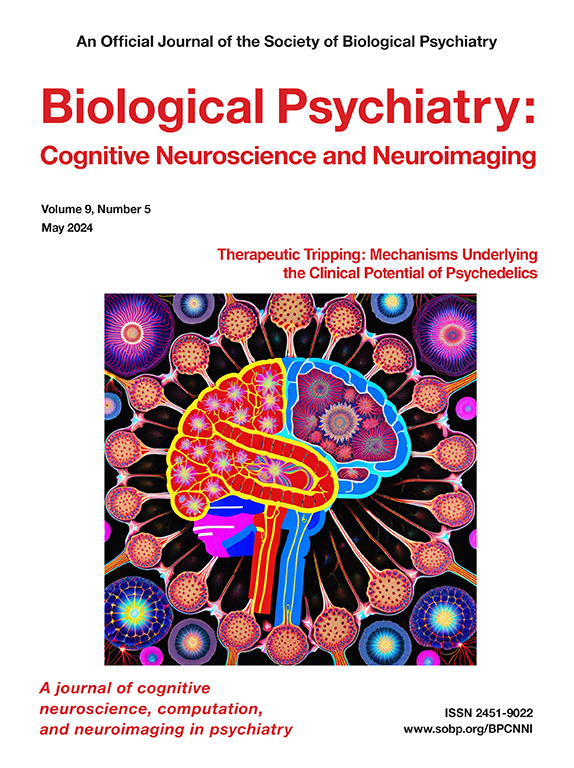多尺度分析揭示海马子野对慢性皮质醇过度暴露的脆弱性:来自库欣病的证据。
IF 4.8
2区 医学
Q1 NEUROSCIENCES
Biological Psychiatry-Cognitive Neuroscience and Neuroimaging
Pub Date : 2025-08-01
DOI:10.1016/j.bpsc.2024.12.015
引用次数: 0
摘要
背景:慢性皮质醇过度暴露在与神经精神和神经退行性疾病相关的神经病理改变的发展中起着重要作用。海马是皮质醇的主要目标,由于其内部异质性,可能表现出特征性的区域反应。本研究探讨慢性皮质醇过度暴露的内源性模型库欣病(CD)海马亚区结构和功能改变。方法:利用来自单个中心的169名参与者(86名CD患者和83名健康对照)的结构和静息状态功能磁共振成像数据,研究了海马亚区特定的结构变化,并探讨了这些结构异常驱动的功能连接改变。我们还分析了这些变化与生物学特性、神经精神表征、认知功能和基因表达谱之间的潜在关联机制。结果:与健康对照相比,CD患者在多个海马亚区表现出明显的双侧体积减少。值得注意的是,左侧海马体和尾子野的体积减少与皮质醇水平、蒙特利尔认知评估得分和生活质量指标显著相关。结构异常的海马体亚区和腹内侧前额叶皮层之间的连接中断可能会损害基于奖励的决策和情绪调节,这种连接障碍与右侧海马体亚区结构变化有关。此外,另一个表现出连接障碍的区域位于左侧苍白球和壳核。与突触成分相关的基因表达模式可能是这些宏观结构改变的基础。结论:我们的研究结果阐明了慢性皮质醇过度暴露对海马的亚场特异性影响,增强了对神经精神和神经退行性疾病中与皮质醇失调相关的共同神经病理特征的理解。本文章由计算机程序翻译,如有差异,请以英文原文为准。
Multiscale Analysis Reveals Hippocampal Subfield Vulnerabilities to Chronic Cortisol Overexposure: Evidence From Cushing’s Disease
Background
Chronic cortisol overexposure plays a significant role in the development of neuropathological changes associated with neuropsychiatric and neurodegenerative disorders. The hippocampus, the primary target of cortisol, may exhibit characteristic regional responses due to its internal heterogeneity. In this study, we explored structural and functional alterations of hippocampal (HP) subfields in Cushing’s disease (CD), an endogenous model of chronic cortisol overexposure.
Methods
Utilizing structural and resting-state functional magnetic resonance imaging data from 169 participants (86 patients with CD and 83 healthy control participants [HCs]) recruited from a single center, we investigated specific structural changes in HP subfields and explored the functional connectivity alterations driven by these structural abnormalities. We also analyzed potential associative mechanisms between these changes and biological attributes, neuropsychiatric representations, cognitive function, and gene expression profiles.
Results
Compared with HCs, patients with CD exhibited significant bilateral volume reductions in multiple HP subfields. Notably, volumetric decreases in the left HP body and tail subfields were significantly correlated with cortisol levels, Montreal Cognitive Assessment scores, and quality of life measures. Disrupted connectivity between the structurally abnormal HP subfields and the ventromedial prefrontal cortex may impair reward-based decision making and emotional regulation, with this dysconnectivity being linked to structural changes in right HP subfields. Another region that exhibited dysconnectivity was located in the left pallidum and putamen. Gene expression patterns associated with synaptic components may underlie these macrostructural alterations.
Conclusions
Our findings elucidate the subfield-specific effects of chronic cortisol overexposure on the hippocampus, enhancing understanding of shared neuropathological traits linked to cortisol dysregulation in neuropsychiatric and neurodegenerative disorders.
求助全文
通过发布文献求助,成功后即可免费获取论文全文。
去求助
来源期刊

Biological Psychiatry-Cognitive Neuroscience and Neuroimaging
Neuroscience-Biological Psychiatry
CiteScore
10.40
自引率
1.70%
发文量
247
审稿时长
30 days
期刊介绍:
Biological Psychiatry: Cognitive Neuroscience and Neuroimaging is an official journal of the Society for Biological Psychiatry, whose purpose is to promote excellence in scientific research and education in fields that investigate the nature, causes, mechanisms, and treatments of disorders of thought, emotion, or behavior. In accord with this mission, this peer-reviewed, rapid-publication, international journal focuses on studies using the tools and constructs of cognitive neuroscience, including the full range of non-invasive neuroimaging and human extra- and intracranial physiological recording methodologies. It publishes both basic and clinical studies, including those that incorporate genetic data, pharmacological challenges, and computational modeling approaches. The journal publishes novel results of original research which represent an important new lead or significant impact on the field. Reviews and commentaries that focus on topics of current research and interest are also encouraged.
 求助内容:
求助内容: 应助结果提醒方式:
应助结果提醒方式:


